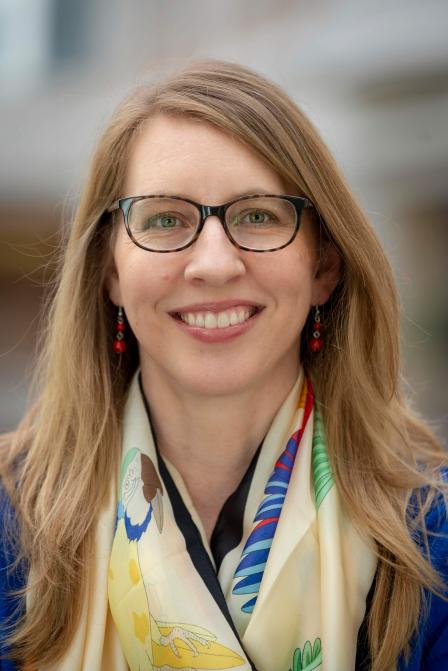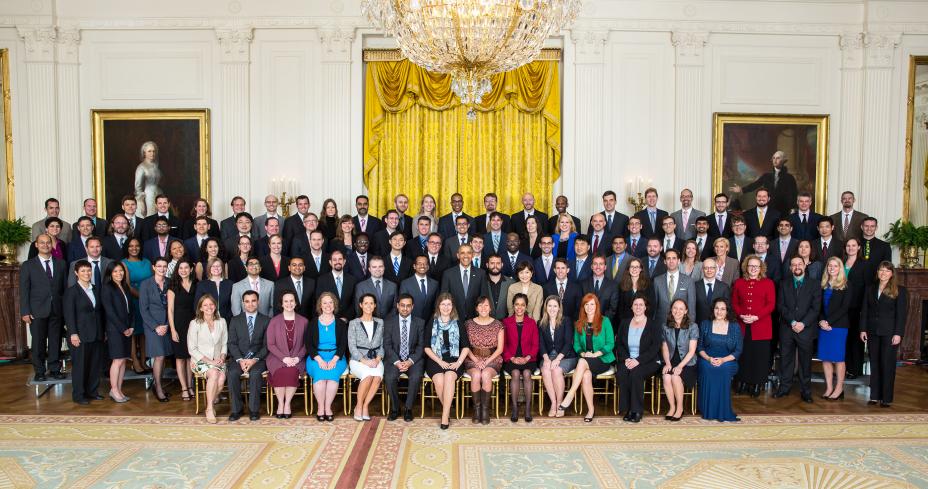Meet EPA Senior Physical Scientist Dr. Rebecca Dodder
Dr. Rebecca Dodder received a 2018 Arthur S. Flemming Award Exitfor her innovative approach to evaluating current and emerging environmental challenges and opportunities related to energy production and use in the United States. She also received the Presidential Early Career Award for Scientists and Engineers in 2016. In 2020, she moved into a supervisory role where she supports an amazing group of scientists and engineers on topics ranging from wildland fires and mobile source emissions to PFAS and ethylene oxide.
 Meet EPA Senior Physical Scientist Dr. Rebecca Dodder!Tell us about your background.
Meet EPA Senior Physical Scientist Dr. Rebecca Dodder!Tell us about your background.
I majored in Physics and Spanish in at Vanderbilt University. Afterwards, I wanted to pursue a career that leveraged my scientific background, but also my interest in public policy. I completed an MA in Science, Technology, and Public Policy at The George Washington University, where I worked on issues ranging from space policy to R&D and economic development. I followed that with a PhD in Technology, Management, and Policy at MIT.
At MIT, I started off as a research assistant in the Nuclear Engineering department. A few weeks into the semester, funding for that project fell through and left me with no funding support. My dual major in Spanish was the key when a classmate told me about an air pollution research project focused on Mexico City. I started on that project working with Nobel Laureate Dr. Mario Molina at MIT. During my research, I traveled to and then lived in Mexico City for several years.
This program at MIT, the Integrated Program on Urban, Regional and Global Air Pollution, lead me into environmental protection, specifically transportation energy and the environment. After my time in Mexico City, where I also did consulting on sustainable transportation, I was a postdoc at MIT for a semester, then started as a federal postdoc with the EPA in Research Triangle Park. I am still working with the same energy system modeling team. I could not have planned my winding path that led me here, but I absolutely love it.
When did you first know you wanted to be a scientist?
Probably in elementary school. I was obsessed with books about the planets, especially Jupiter (and, yes, Pluto was still a planet when I was a kid). I also thought black holes were fascinating and was just generally interested in scientific developments.
In high school, I had a wonderful AP Physics teacher. As a women scientist, she was a supportive and encouraging mentor. I think that was probably one of the first times that I started to really gain confidence that I could excel in science. This confidence was key, especially as I was sometimes the only woman in my physics classes.
How does your science matter?
My team’s work focuses on looking at different ways that the energy system can change over time—looking out 50 years into the future. We use energy system models to look at not only the electric sector but also at energy use in transportation, residential, and commercial buildings, and the industrial sector. We look at how different long-term energy scenarios may affect climate, air quality, and water use. For example, when looking at water use and the energy system, we consider a wide range of scenarios and ask questions such as: “How could constraints on water availability affect the energy system and where are there potential tradeoffs or co-benefits? Can moving towards a lower carbon future also be beneficial on the water side?” In many cases, reducing carbon also reduces our water demand for energy production. We try to be forward-looking and look at a broader range of environmental impacts from a systems-level perspective.
What do you like most about your research?
What I like most is looking at how my team can connect our work to other tools, groups, or research efforts. One of the neat things about that is the relationships you form working with people from different disciplines. It’s really enriching to do interdisciplinary work because it makes you look at your own system and problems from a different perspective. Our energy system work is usually focused on air and climate, so one of the things that I really enjoyed doing was bringing in the water use aspect as well.
If you could have dinner with any scientist, past or present, who would it be? What would you ask him/her?
Marie Curie. I would love to hear her story of how she persisted as a woman pursing science in the late 1800s and turn of the century and would go on to be the first women to win a Noble Prize and the only person to win the Nobel Prize in two scientific fields.
If you weren’t a scientist, what would you be doing?
I can’t really imagine doing something that doesn’t involve some science. But, I would be outdoors somewhere, perhaps outdoor recreation or environmental education. I volunteer with a non-profit that aims to get kids outdoors, and I think it is so important for kids to connect to nature.
If you could have one superpower, what would it be and why?
This might not count as a superpower but I would want to have “The Force.” Why? Because, I grew up on Star Wars.
Any advice for students considering a career in science?
My main advice would be for them to be open-minded and realize that it’s not always going to be a direct trajectory to exactly where they want to be, and they need to take advantage of opportunities and leverage skills that are not necessarily scientific. I was able to leverage Spanish to get onto a project that really opened doors and defined where I ended up in my career. It was a skill that I continued to foster without really any knowledge of how it would be advance me in my career. I think keeping some of those passions and skills alive is important.
What do you think the coolest scientific discovery was and why?
The detection of gravitational waves in 2015 was pretty cool. These “ripples in space” were two black holes colliding 1.3 billion years ago! The idea of long-standing ideas from theoretical physics being confirmed and detected through experimentation decades later is a testament to how science moves forward.
What do you think is our biggest scientific challenge in the next 20/50/100 years?
From my perspective on the energy side, our biggest challenge is how we start to manage some of the transitions we need to make to get to a more sustainable energy system. Understanding how we move there, not just on the technology side but also the societal side, is critical. It’s not so much a matter of delving in deep to a specific area or technology, but just understanding how you move the entire system forward.
Whose work in your scientific field are you most impressed by?
I am always impressed by Dan Sperling in the field of transportation and energy. His work is interdisciplinary and he brings together people from all facets of government, private, and non-profit sectors to continuously engage in dialogue about transportation, energy, and the environment. I think his convening powers and ability to bring science to policy have advanced the field in terms of how people look at transportation energy issues and communicate around them.
 President Barack Obama joins recipients of the Presidential Early Career Award for Scientists and Engineers, including Dr. Rebecca Dodder (center, back row) for a group photo in the East Room of the White House, May 5, 2016. (Official White House Photo by Lawrence Jackson)
President Barack Obama joins recipients of the Presidential Early Career Award for Scientists and Engineers, including Dr. Rebecca Dodder (center, back row) for a group photo in the East Room of the White House, May 5, 2016. (Official White House Photo by Lawrence Jackson)
Editor's Note: The opinions expressed herein are those of the researcher alone. EPA does not endorse the opinions or positions expressed.
